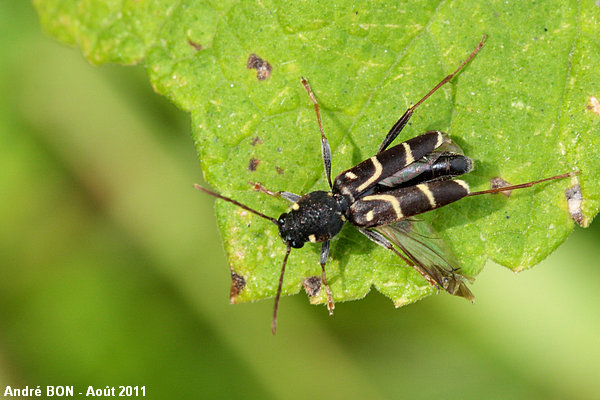
| Xylotrechus antilope (Schönherr, 1817) |

|
|
Scientific name: Xylotrechus antilope (Schönherr, 1817) Common name: French name: Clyte antilope Order: Coleoptera Family: Cerambycidae Wingspan : 7-14 mm. Biotope: Oak forests. The larvae exclusively grow in oak wood, under the bark of dead or dry branches. The development cycle lasts two years. Geographic area: Europe, the Caucasus, Iran, Near-East. North Africa. Observation period : May to August. |
The longhorn beetles of the Xylotrechus genus are lengthy and shiny and show a V-shape keel on the frons. The antennae are short and strong. The pronotum is round-shaped. Xylotrechus antilope's pronotum shows rough asperities in the centre while it is more finely granulated near the edges. The pronotum is slightly longer than wide on males and rather transverse on females. The maximum width of the pronotum is at the posterior third. The front shows an interrupted yellow stripe. The first elytral stripe is reduced to two thin oblique yellow strokes on the shoulders. The other yellow marks are thinner than on the other similar species. The antennae, the tibias and the tarsi are reddish brown. The antennae are rather thick and hardly reach the middle of the elytra on males. They are even slightly shorter on females. The apex of the elytra draws some kind of a V-shaped space. There is a small tooth on the external edge of each elytra. Xylotrechus arvicola shows broader marks and straight oriented (not oblique) patches on the shoulders. |
| [To know more about the Xylotrechus antilope] [Top] |

|
This Xylotrechus antilope, observed on a woodland edge, shows damaged wings. I have read that this insect is rather rarely observed but population is increasing in the French region of Ile de France. |